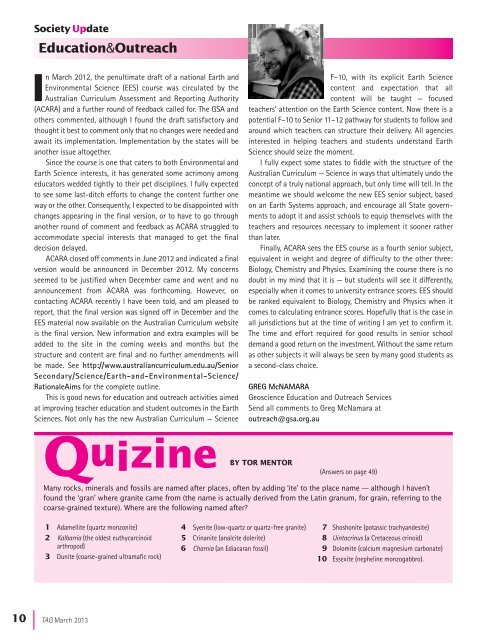TAG 166 - Geological Society of Australia
TAG 166 - Geological Society of Australia
TAG 166 - Geological Society of Australia
Create successful ePaper yourself
Turn your PDF publications into a flip-book with our unique Google optimized e-Paper software.
<strong>Society</strong> UpdateEducation&OutreachIn March 2012, the penultimate draft <strong>of</strong> a national Earth andEnvironmental Science (EES) course was circulated by the<strong>Australia</strong>n Curriculum Assessment and Reporting Authority(ACARA) and a further round <strong>of</strong> feedback called for. The GSA andothers commented, although I found the draft satisfactory andthought it best to comment only that no changes were needed andawait its implementation. Implementation by the states will beanother issue altogether.Since the course is one that caters to both Environmental andEarth Science interests, it has generated some acrimony amongeducators wedded tightly to their pet disciplines. I fully expectedto see some last-ditch efforts to change the content further oneway or the other. Consequently, I expected to be disappointed withchanges appearing in the final version, or to have to go throughanother round <strong>of</strong> comment and feedback as ACARA struggled toaccommodate special interests that managed to get the finaldecision delayed.ACARA closed <strong>of</strong>f comments in June 2012 and indicated a finalversion would be announced in December 2012. My concernsseemed to be justified when December came and went and noannouncement from ACARA was forthcoming. However, oncontacting ACARA recently I have been told, and am pleased toreport, that the final version was signed <strong>of</strong>f in December and theEES material now available on the <strong>Australia</strong>n Curriculum websiteis the final version. New information and extra examples will beadded to the site in the coming weeks and months but thestructure and content are final and no further amendments willbe made. See http://www.australiancurriculum.edu.au/SeniorSecondary/Science/Earth-and-Environmental-Science/RationaleAims for the complete outline.This is good news for education and outreach activities aimedat improving teacher education and student outcomes in the EarthSciences. Not only has the new <strong>Australia</strong>n Curriculum — ScienceF–10, with its explicit Earth Sciencecontent and expectation that allcontent will be taught — focusedteachers’ attention on the Earth Science content. Now there is apotential F–10 to Senior 11–12 pathway for students to follow andaround which teachers can structure their delivery. All agenciesinterested in helping teachers and students understand EarthScience should seize the moment.I fully expect some states to fiddle with the structure <strong>of</strong> the<strong>Australia</strong>n Curriculum — Science in ways that ultimately undo theconcept <strong>of</strong> a truly national approach, but only time will tell. In themeantime we should welcome the new EES senior subject, basedon an Earth Systems approach, and encourage all State governmentsto adopt it and assist schools to equip themselves with theteachers and resources necessary to implement it sooner ratherthan later.Finally, ACARA sees the EES course as a fourth senior subject,equivalent in weight and degree <strong>of</strong> difficulty to the other three:Biology, Chemistry and Physics. Examining the course there is nodoubt in my mind that it is — but students will see it differently,especially when it comes to university entrance scores. EES shouldbe ranked equivalent to Biology, Chemistry and Physics when itcomes to calculating entrance scores. Hopefully that is the case inall jurisdictions but at the time <strong>of</strong> writing I am yet to confirm it.The time and effort required for good results in senior schooldemand a good return on the investment. Without the same returnas other subjects it will always be seen by many good students asa second-class choice.GREG McNAMARAGeoscience Education and Outreach ServicesSend all comments to Greg McNamara atoutreach@gsa.org.auQ u izine(AnswersBY TOR MENTORon page 49)Many rocks, minerals and fossils are named after places, <strong>of</strong>ten by adding ‘ite’ to the place name — although I haven’tfound the ‘gran’ where granite came from (the name is actually derived from the Latin granum, for grain, referring to thecoarse-grained texture). Where are the following named after?1 Adamellite (quartz monzonite)2 Kalbarria (the oldest euthycarcinoidarthropod)3 Dunite (coarse-grained ultramafic rock)4 Syenite (low-quartz or quartz-free granite)5 Crinanite (analcite dolerite)6 Charnia (an Ediacaran fossil)7 Shoshonite (potassic trachyandesite)8 Uintacrinus (a Cretaceous crinoid)9 Dolomite (calcium magnesium carbonate)10 Essexite (nepheline monzogabbro).10 |<strong>TAG</strong> March 2013
















